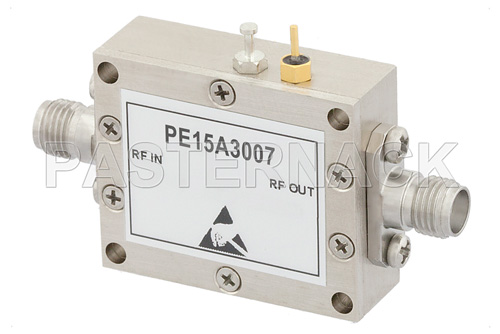 The input and output power characteristics of an RF amplifier are dominant characteristics, as increasing signal strength is the primary purpose of an amplifier. An RF amplifier will be specified with a maximum and nominal range for input and output power based on certain conditions. These specifications will further extend to a maximum and nominal range for input and output voltage and current. If the power, current, or voltage presented at the inputs or outputs exceeds the specification, undesirable operation and even device damage may occur.
The input and output power characteristics of an RF amplifier are dominant characteristics, as increasing signal strength is the primary purpose of an amplifier. An RF amplifier will be specified with a maximum and nominal range for input and output power based on certain conditions. These specifications will further extend to a maximum and nominal range for input and output voltage and current. If the power, current, or voltage presented at the inputs or outputs exceeds the specification, undesirable operation and even device damage may occur.
An important note with amplifiers used in pulsed or other applications with signal modulation is that certain types of modulation may change the power, voltage, or current of the base continuous wave signal. This could potentially lead to exceeding certain recommended limits. For example, frequency or phase modulation doesn’t increase signal power, but amplitude modulation can increase signal power up to four times that of a continuous wave (CW) signal. Knowledge of the input and output power characteristics over frequency is necessary to ensure acceptable operation ranges at every frequency.
A common parameter given to represent the input and output power characteristics for any amplifier is gain, or the output signal power compared to the input signal power. For RF amplifiers, this parameter is given over a frequency range. As the RF amplifier gain will not be completely consistent over frequency, the gain flatness of the frequency response can be derived by measuring the peak to peak gain behavior. In some circumstances, a signal may be presented at the output port of an RF amplifier, either through reflection or other system dynamics. The output to input gain, or reverse gain, is used to gauge the effects of signals present on the output of the amplifier to the input of the amplifier and the upstream signal chain. Additionally, some energy will be lost within the RF amplifier device, which may need to be factored into system performance considerations.
No physical device will output all of the input supply power and input signal power. There are RF conversion losses, internal resistive losses, impedance mismatches, and coupling effects that pull power away from the output of the amplifier. A measure of the power input to the amplifier compared to the realized output power is known as efficiency. As this is a main consideration in many RF power amplifier (PA) applications, power-added efficiency (PAE) includes the RF input power into the calculation. There are several other methods of calculating efficiency, which should be investigated to determine if it is adequate for a particular application.




 Pasternack Blog
Pasternack Blog
